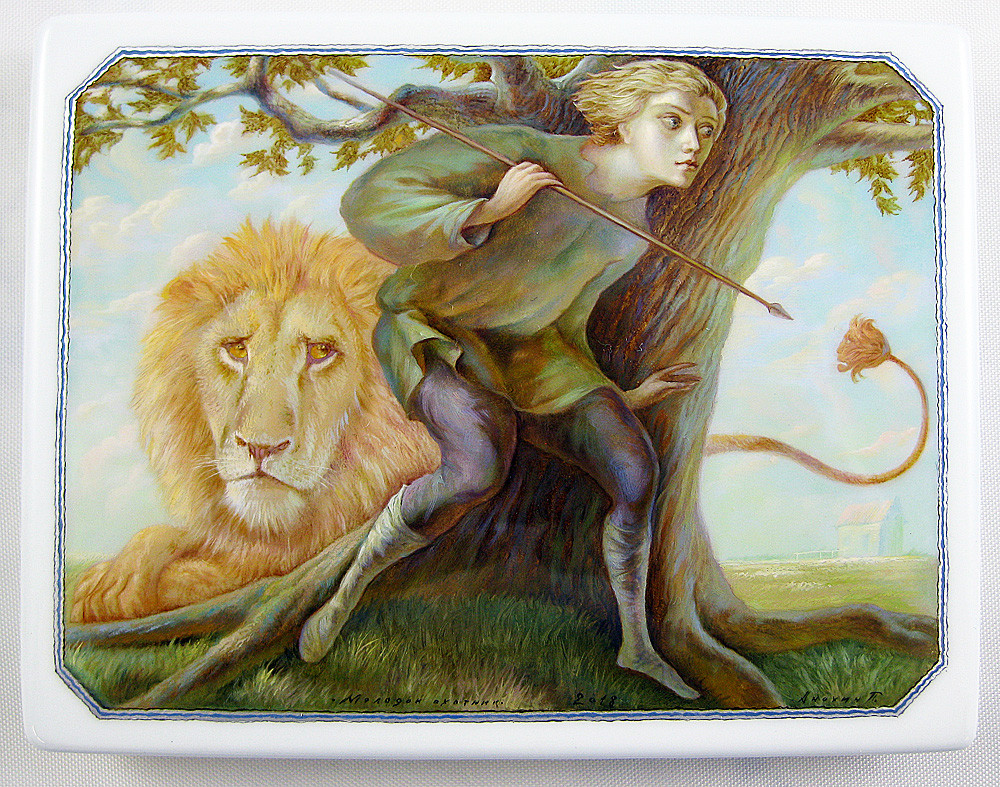Lacquer boxes were first produced near Fedoskino, a village located on the banks of the Ucha River, just 24 miles north of Moscow. Today, Fedoskino has approximately 2,500 inhabitants and supports a thriving art industry that originated over two centuries ago. The original school and guild of Russian lacquer miniature painting was founded in Fedoskino in 1795. Today nearly three hundred artists and scores of highly skilled craftsmen support their families by producing the uniquely beautiful works of art we call Russian lacquer miniatures.
The landscape surrounding the village of Fedoskino is rich with natural beauty to inspire artistic creativity. The velvet green of the pinewoods, the silvery birch copses, and the changing seasons reflected in the waters of the Ucha river - all find their way into the paintings of Fedoskino's lacquer miniature artists.
While lacquer painting on wood emerged in Russia in the first half of the 18th century, the unique art of miniature painting of papier-mâché did not take root until 1795 when the techniques for making the papier-mâché articles were brought back to Russia from Germany.
During the late 18th century taking snuff had become very popular in Europe and many workshops were established to fill the demand for decorative snuffboxes. At first snuffing was confined to high society as tobacco was an expensive imported product. It was natural then, that the early snuff boxes were also made of costly materials such as ivory, gold, silver, gems, and tortoiseshell. As snuff became less expensive and the practice of taking snuff extended to the middle and lower classes, a demand for inexpensive snuff boxes emerged. Several workshops in Europe began to mass produce snuffboxes to fill this demand. Late in the 18th century a Russian merchant named Piotr Korobov visited one of these workshops, the Johann Stobwasser's manufactory in Braunschweig, Germany and was impressed by the enterprise that produced good quality items from papier-mâché and lacquer. He quickly understood that he could incorporate the methods and materials used by Stobwasser to mass-produce inexpensive snuffboxes and other items back in Russia where there was a growing market.
With some paints and lacquer purchased from Stobwasser, and several of Stobwasser's artists-craftsmen, Korobov returned home to open his own workshop in Danilkovo just outside Fedoskino. His new enterprise employed between twenty and thirty people in the production of simple papier-mâché snuff boxes and varnished peaks for military caps and helmets. The earliest snuff boxes were plain polished lacquer or had cut outs of popular prints glued to the surface of the boxes and lacquered over. Several small competing workshops soon opened and by the early years of the 19th century, the lacquer workshops in Danilkovo and Fedoskino produced approximately 13,000 lacquered papier-mâché articles per year that were sold throughout Europe.
In 1818, control of the Korobov workshop passed to his son-in-law, Piotr Lukutin who expanded production to include tea caddies, album covers,desk accessories, and boxes for many different purposes. Artists began to hand paint intricate decorative motifs on the boxes, and these small paintings became status symbols among the aristocracy and wealthy merchant class. As demand for the lacquered papier-mâché items grew, so did the complexity of design and decoration. Just five years after Lukutin took over, the workshop employed over fifty skilled painters, and a school at the factory was training apprentices.
In 1828 Piotr Lukutin began exhibiting his products at industrial and handcraft fairs in Russia and Europe, winning public acclaim and many awards. It was this same year that Lukutin received the highest honor, a royal edict, allowing him to use the Imperial emblem of the double-headed eagle and his initials as the company trademark. Alexander Lukutin joined his father as factory manager in 1841, and together they transformed a simple craft into a genuine art form through daring innovation in subject-matter and technique.
The main competitor of the Lukutin workshop was the lacquer workshop of Osip Fillipovich Vishnyakov founded in the nearby village of Ostashkovo in the 1780s. Vishnyakov was a former serf freed from the Sheremetev Family Estate. Vishnyakov and his sons produced a variety of papier-mâché lacquer ware items including: snuffboxes, tea boxes, eyeglass cases, matchboxes, and Easter eggs. They sold their wares in Moscow at the various fairs and markets. This workshop flourished into the mid-1800s.
The Vishnyakov and Lukutin workshops were in fierce competition and frequently their paintings depicted similar scenes such as the racing winter troika. Not only were such scenes popular, but some of the artists moved back and forth between the two workshops resulting in stylistic and thematic similarities in they items produced. The lacquer ware produced in this era was not signed by the artist, therefore it is nearly impossible to know who painted a specific piece.
Most of the lacquer miniature paintings from this era were hand rendered reproductions of famous paintings and popular illustrations rather than being original compositions. However, these lacquer miniatures distinguished themselves from the works that inspired them due to the techniques used in their creation and the resulting depth and illumination in the painting. The techniques include the use of a primed papier-mâché surface with a background of metal powder over which several layers of thin oil paint were applied.
In the mid-19th century the Vishnyakov workshop began production of lacquered metal trays. The production of painted metal trays, subsequently, branched into a separate industry centered in Zhostovo.
The Lukutin workshop was finally closed in 1904 and some of the artists transferred to the Vishnyakov workshop. Many of the artists found the working conditions there unacceptable and in 1910 they banded together to form the Fedoskino Artel.

